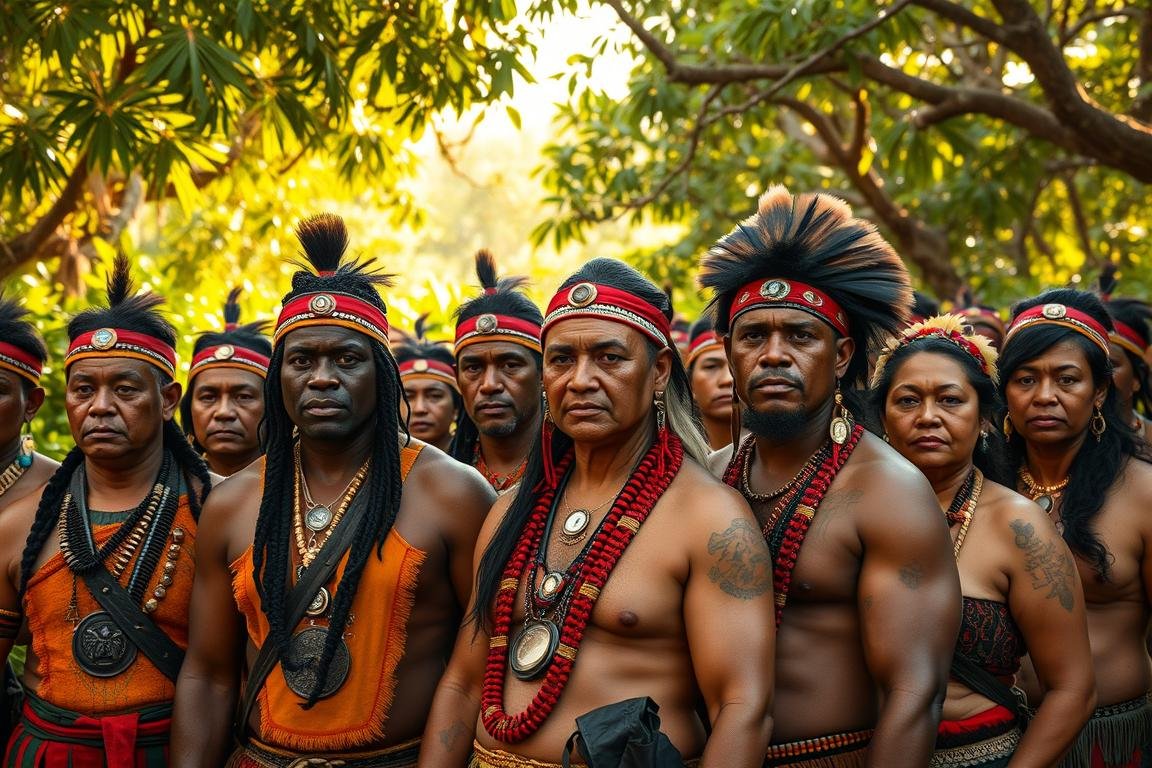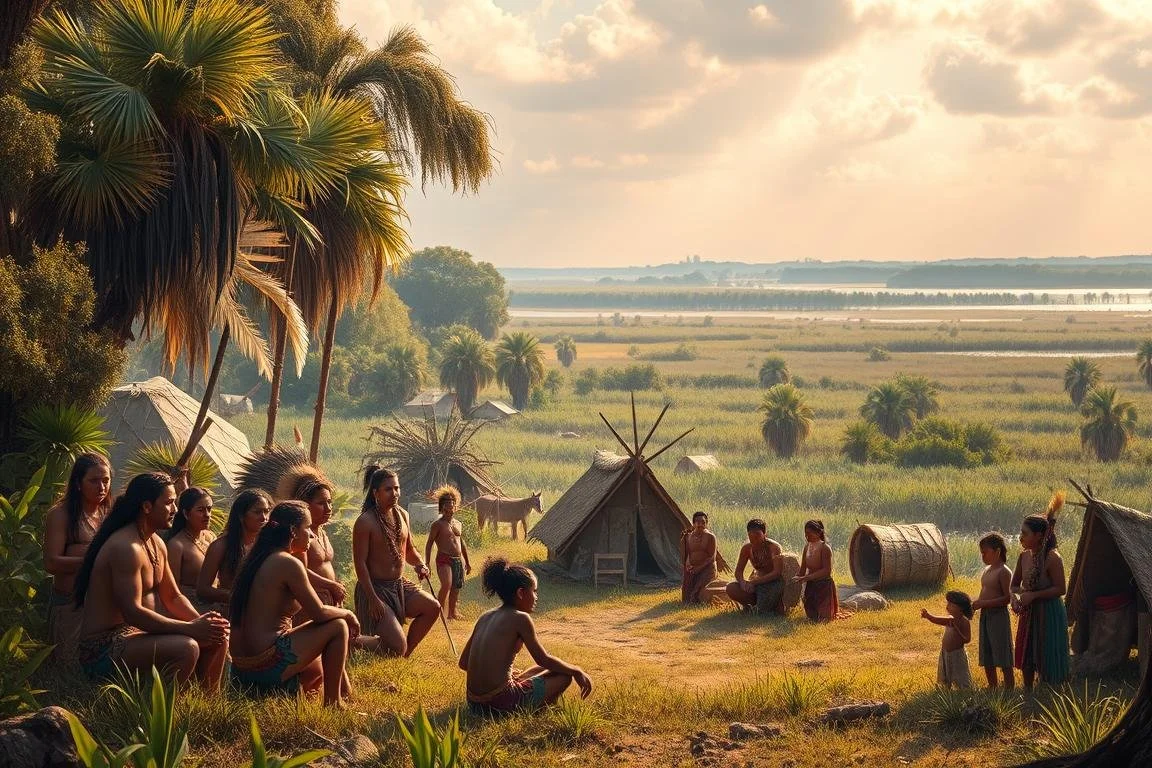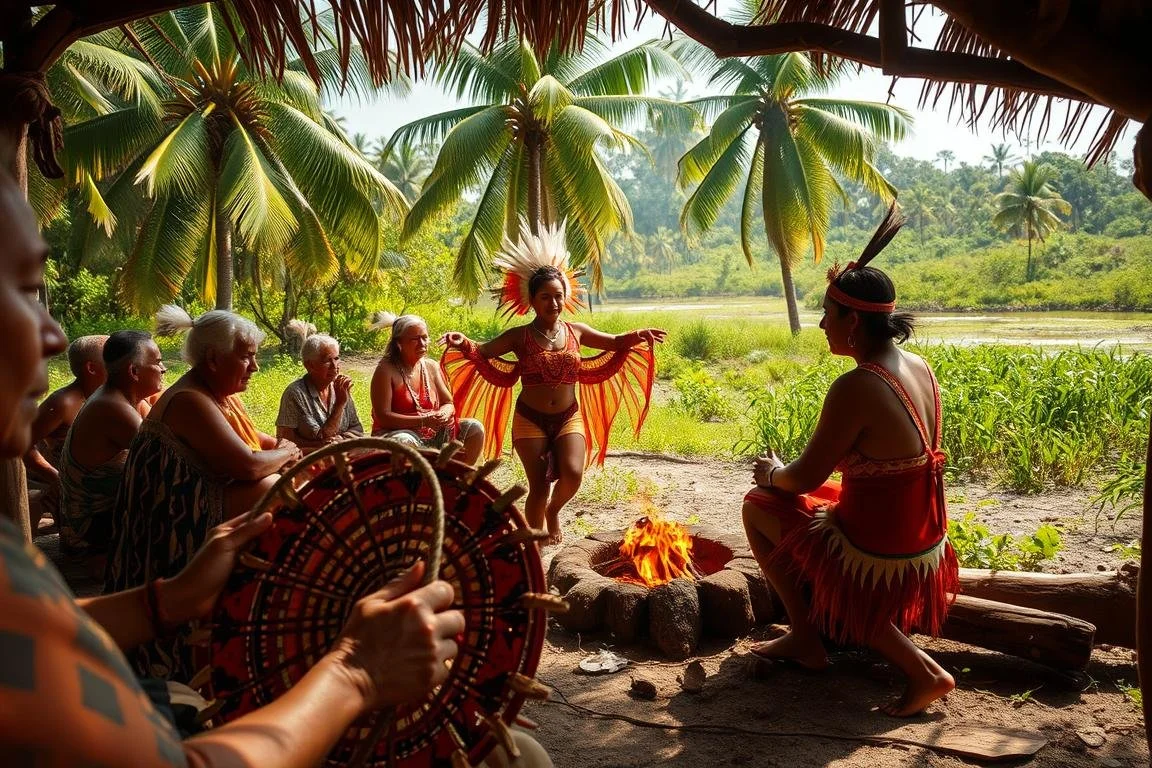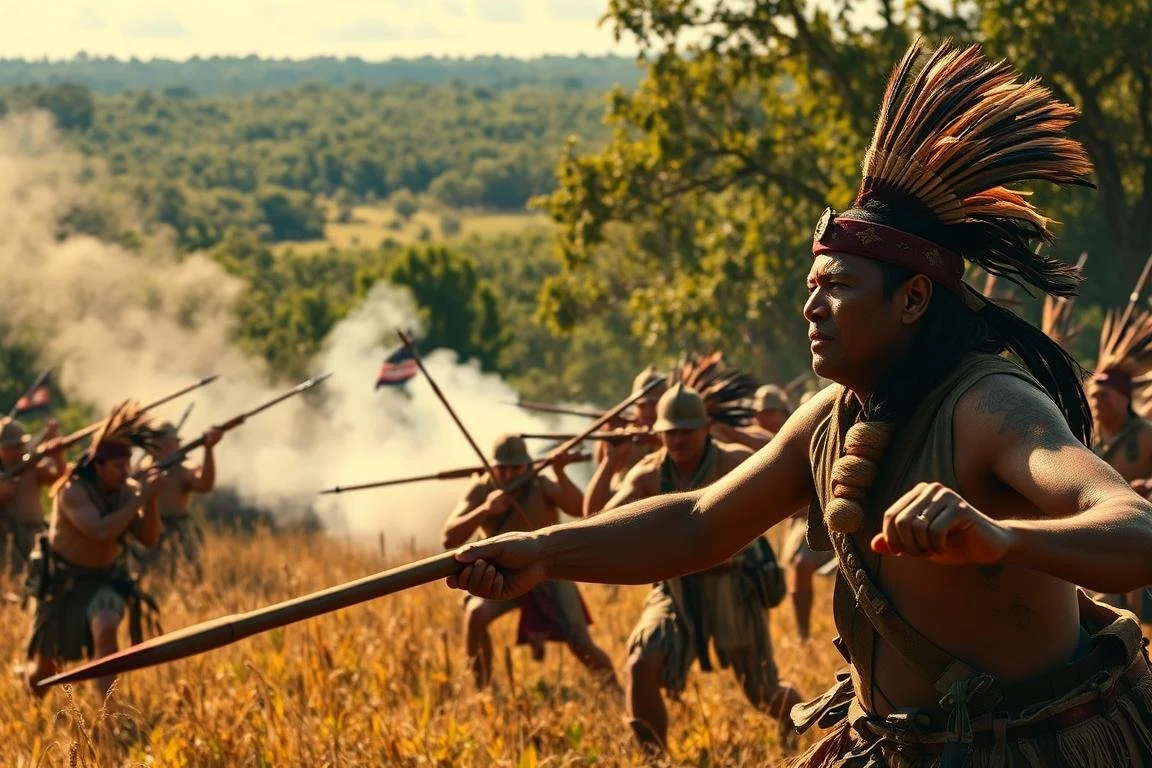Seminole Nation: Unconquered
As I embark on this journey to explore the Seminole Nation, I'm drawn into a rich tapestry of history, culture, and resilience. The Seminole people, known as the unconquered, have a story that spans centuries, filled with tales of bravery and adaptation.
Seminole Nation
Nation
Their history is a testament to the unwavering spirit of a community that has thrived against all odds.
In this article, we'll delve into the origins, traditions, and modern-day endeavors of Florida's indigenous people, uncovering the essence of their unconquered spirit.
Key Takeaways
Discover the rich history and culture of the Seminole Nation.
Learn about the resilience and bravery of the unconquered people.
Explore the traditions and modern endeavors of Florida's indigenous community.
Understand the significance of preserving local stories and environmental stewardship.
Gain insight into the community's unwavering spirit and its impact on their way of life.
The Origins of the Seminole People
With roots tracing back to various indigenous groups, the Seminole people's origins are a fascinating tale of migration and adaptation.
The story of how they came to be known as the "Seminole" is deeply intertwined with their history in Florida.
Early Migration to Florida
The Seminole people's journey to Florida began in the 18th century, driven by various factors including conflict and the search for new lands.
They migrated from what is now Georgia and Alabama, bringing with them their cultural practices and traditions.
Creek Ancestry and Influences
A significant aspect of Seminole identity is their Creek ancestry.
The Creek Nation's influence on the Seminole people is evident in their language, customs, and social structures.
This heritage played a crucial role in shaping their distinct identity.
InfluenceDescriptionLanguageThe Seminole language is closely related to the Creek language, reflecting their shared heritage.
Many Seminole customs, such as their traditional dances and ceremonies,
have Creek origins. The Seminole people's social organization, including their clan system, was influenced by Creek traditions.
Formation of a Distinct Identity
As the Seminole people settled in Florida, they began to forge a distinct identity that was separate from,
Yet influenced by their Creek ancestry.
Their interactions with other indigenous groups,
as well as with European colonizers and African Americans, contributed to the development of a unique cultural identity.
The Seminole Nation: Formation and Early Structure
As the Seminole Nation began to take shape, its social and political structures evolved in response to its unique environment.
This evolution was crucial in defining their identity and resilience in the face of external challenges.
Seminole Nation formation
Political Organization and Clan System
The Seminole Nation's political organization was deeply rooted in its clan system.
The clan system was a matrilineal society where property and social ties were passed down through the maternal line.
This system played a significant role in determining social roles, responsibilities, and even influenced their governance structure.
The clans were not just social units; they were also political entities that contributed to the overall decision-making process.
Tribal Leadership and Governance
Tribal leadership among the Seminoles was characterized by a council-based system. Leaders, often referred to as "headmen," were chosen based on their wisdom, bravery, and ability to mediate disputes.
The governance structure was relatively decentralized, allowing for a degree of autonomy among different bands and clans.
This decentralization enabled the Seminoles to adapt to changing circumstances and resist external control.
Alliances with Maroons and Other Indigenous Groups
The Seminoles formed significant alliances with Maroons (escaped African slaves) and other indigenous groups.
These alliances were mutually beneficial, providing the Seminoles with additional military strength and cultural exchange,
while the Maroons gained refuge and protection. Such alliances further enriched the Seminole culture and enhanced their political and social resilience.
Seminole Nation Formation
Cultural Heritage and Traditions
The vibrant cultural heritage of the Seminole Nation is evident in their traditional practices and arts.
Their culture is a living, breathing entity that continues to thrive through the generations.
Seminole culture
Traditional Practices and Ceremonies
The Seminole people have a rich tradition of ceremonies and practices that are integral to their cultural identity.
These ceremonies often revolve around the natural world and the cycles of nature, reflecting their deep connection to the land.
Some of these traditional practices include the Green Corn Ceremony,
which celebrates the harvest season, and various rituals that honor the spirits and ancestors.
Distinctive Seminole Arts and Crafts
Seminole arts and crafts are renowned for their beauty and intricacy. The tribe is particularly known for its basket weaving,
woodcarvings, and beadwork, all of which are made with great skill and attention to detail.
Art Form Description Significance Basket Weaving Intricately woven baskets made from natural fibers.
Used for storage and ceremonial purposes. Beadwork: Colorful beadwork adorning clothing and accessories.
Symbolizes status, spirituality, and cultural identity. Woodcarvings: Exquisite carvings made from various types of wood. Often used in storytelling and ceremonial contexts
Patchwork Clothing and Beadwork
One of the most distinctive aspects of Seminole culture is their patchwork clothing, which is both beautiful and meaningful.
The intricate designs and patterns are not only aesthetically pleasing but also carry significant cultural and spiritual meaning.
Their beadwork is equally impressive, with intricate patterns and designs that are used to adorn clothing and accessories.
Language and Oral Traditions
The Seminole language is a vital part of their cultural heritage, and their oral traditions are rich with stories, legends, and historical accounts.
These stories are passed down through generations, serving as a vital link to their ancestors and cultural identity.
Their oral traditions also include songs, chants, and other forms of expression that are integral to their ceremonies and daily life.
The Seminole Wars: Resistance Against Removal
As we explore the Seminole Wars, it becomes clear that these conflicts were not just about territorial disputes but about the resilience of a people determined to remain unconquered.
The Seminole Wars mark a pivotal chapter in the history of the Seminole Nation,
a period of resistance against forced removal that tested the mettle of their unconquered spirit.
Seminole Wars resistance
First Seminole War
The First Seminole War (1816-1819) was sparked by the U.S. government's attempt to suppress the Seminole resistance and capture runaway slaves who had found refuge among the Seminoles. This conflict saw the destruction of the Negro Fort in 1816, an event that heightened tensions.
The war was characterized by skirmishes and strategic maneuvers, ultimately leading to the signing of treaties that temporarily eased hostilities.
Second Seminole War
The Second Seminole War (1835-1842) was the most intense and prolonged of the three conflicts, marked by guerrilla warfare and leadership from figures like Osceola. The war was a response to the U.S. government's relentless push for Seminole removal, as outlined in the Indian Removal Act of 1830.
Despite being outnumbered, the Seminoles employed effective tactics, including hit-and-run attacks and utilizing the challenging terrain of the Everglades to their advantage.
Third Seminole War
The Third Seminole War (1855-1858) saw a decrease in the scale of hostilities compared to the previous conflict but was marked by continued resistance against U.S. forces.
The war eventually dwindled, with many Seminoles either captured or forced deeper into the Everglades.
This period marked the beginning of a long process of adaptation and survival for the Seminole people.
The Legacy of Unconquered Resistance
The Seminole Wars left an indelible mark on the Seminole Nation, symbolizing their unconquered spirit and determination to preserve their way of life. The legacy of these wars continues to inspire the Seminole people, serving as a testament to their resilience and cultural strength.
Osceola and Other Seminole Leaders
Leadership has been a cornerstone of the Seminole Nation, with figures like Osceola embodying the spirit of resilience and defiance.
The history of the Seminoles is replete with stories of courageous leaders who fought against overwhelming odds to preserve their way of life.
Osceola Seminole Leader
The Life and Legacy of Osceola
Osceola, whose name means "Black Drink Cry" or "Rising Black Water," was a key figure in the Second Seminole War. Born around 1804,
Osceola rose to prominence due to his fierce resistance against the forced removal of the Seminoles from their lands in Florida.
His leadership and strategic prowess made him a thorn in the side of the U.S. military, earning him a revered place in Seminole history.
Notable Male Chiefs and Warriors
Beyond Osceola, other notable male leaders played crucial roles in Seminole history.
Leaders like Micanopy and Charley Emathla were significant figures during the Seminole Wars,
each contributing their unique leadership qualities to the resistance.
These men, along with others, helped shape the Seminole Nation's response to external pressures and internal challenges.
Influential Seminole Women Leaders
Seminole women have also been pivotal in the leadership and cultural preservation of the Nation.
Women like Betty Mae Tiger Jumper, who became the first female chairperson of the Seminole Tribe of Florida in the 20th century,
have continued the legacy of strong leadership. Their contributions span from cultural preservation to political leadership, ensuring the Seminole Nation remains vibrant and resilient.
LeaderSignificancePeriodOsceolaLed resistance in the Second Seminole War1804-1838MicanopyKey figure during the Seminole Wars1780s-1840sBetty Mae Tiger JumperFirst female chairperson of the Seminole Tribe of Florida1920s-2011
Survival in the Everglades
For centuries, the Seminole people have called the Everglades home, developing a profound connection with the land and its creatures.
This unique ecosystem, with its vast wetlands and diverse wildlife, has been both a challenge and a haven for the Seminoles.
Adaptation to the Wetland Environment
The Seminole Nation's ability to adapt to the Everglades' challenging environment is a testament to their resilience and resourcefulness.
Over time, they have developed a deep understanding of the land, learning to navigate its waters, predict its seasonal changes,
and utilize its resources sustainably.
Key adaptations include:
Developing traditional knowledge of the wetland's flora and fauna
Mastering techniques for hunting and fishing that are in harmony with the environment
Creating homes that are suited to the wetland conditions
Chickee Homes and Traditional Architecture
One of the most iconic aspects of Seminole architecture is the Chickee home.
These structures are designed to withstand the harsh conditions of the Everglades,
with raised platforms that protect against flooding and thatched roofs that provide insulation.
The design of Chickee homes reflects the Seminole people's deep connection to their environment,
using materials that are locally sourced and sustainable.
Hunting, Fishing, and Agricultural Practices
The Seminoles have developed sophisticated practices for hunting, fishing, and agriculture that are tailored to the Everglades' unique ecosystem. These practices not only provide sustenance but also play a crucial role in maintaining the balance of the environment.
Practice Description: Seasonality, Hunting, Utilizing traditional knowledge to hunt wildlife such as deer and birdsDry seasonFishingEmploying techniques passed down through generations to catch fish and other aquatic resourcesYear-roundAgricultureCultivating crops that are resilient to the Everglades' conditions, such as corn and squash. Wet season
The Divided Seminole: Oklahoma and Florida
The Seminole people, known for their resilience, were historically divided into two main groups: the Seminole Nation of Oklahoma and the Seminole Tribe of Florida. This division was a result of the forced relocations during the 19th century, particularly during the Seminole Wars.
The Seminole Nation of Oklahoma
The Seminole Nation of Oklahoma was established after the forced relocation of many Seminoles from Florida during the Seminole Wars.
The Trail of Tears was a brutal reminder of the U.S. government's resolve to remove Native American tribes from their ancestral lands.
Today, the Seminole Nation of Oklahoma continues to thrive, maintaining its cultural heritage through various traditions and practices.
The Seminole Tribe of Florida
In contrast, the Seminole Tribe of Florida managed to resist removal and remained in their ancestral lands. They adapted to the challenging environment of the Everglades, developing unique survival strategies.
The Seminole Tribe of Florida continues to preserve its distinct identity, with a strong emphasis on cultural preservation and community development.
Maintaining Cultural Connections Despite Separation
Despite the geographical separation, both the Seminole Nation of Oklahoma and the Seminole Tribe of Florida have maintained strong cultural connections. They share a common history and many traditions, including their language, crafts, and ceremonial practices.
Regular cultural exchanges and joint community events help to strengthen these bonds, ensuring that the Seminole people remain united in their heritage.
Cultural AspectSeminole Nation of Oklahoma, Seminole Tribe of Florida. Language Preserved through community programsTaught in tribal schools. Traditional CraftsKnown for intricate beadworkFamous for patchwork clothingCeremonial Practices to perform traditional dancesMaintains an annual Green Corn Ceremony
Through these efforts, the Seminole people continue to celebrate their rich cultural heritage, despite historical divisions. The story of the Seminole Nation is one of resilience and the enduring power of cultural identity.
Modern Seminole Communities and Economic Development
With a strong foundation in their cultural identity, the modern Seminole are diversifying their economy through innovative ventures. This blend of tradition and progress is evident in their various economic development initiatives.
Gaming Enterprises and Economic Sovereignty
The Seminole Tribe has made significant strides in the gaming industry, operating several casinos that not only generate substantial revenue but also create jobs and stimulate local economies. These gaming enterprises are crucial to their economic sovereignty, enabling the tribe to be self-sufficient.
Gaming Revenue: A significant portion of the revenue generated from gaming activities is reinvested into the community, supporting vital services such as healthcare, education, and infrastructure development.
Tourism and Cultural Attractions
Tourism is another vital sector for the Seminole, offering visitors a chance to experience their rich culture firsthand. From traditional dance performances to authentic Seminole crafts, tourism initiatives help share the Seminole story with the world.
Cultural Exchange: Through tourism, the Seminole can engage in cultural exchange, promoting understanding and appreciation of their heritage while generating income.
Environmental Stewardship in the Everglades
The Seminole have a deep connection to the Everglades, their ancestral home. Recognizing the importance of preserving this unique ecosystem, they are actively involved in environmental stewardship efforts, protecting the land and its wildlife for future generations.
Conservation Efforts: The tribe participates in various conservation programs, aiming to maintain the delicate balance of the Everglades ecosystem.
Education and Knowledge Preservation
Education is a cornerstone of Seminole community development. The tribe places a strong emphasis on preserving their knowledge and cultural heritage, ensuring that their history and traditions are passed down to younger generations.
Economic InitiativeDescriptionImpactGaming EnterprisesOperation of casinos and gaming facilitiesJob creation and revenue generationTourismCultural attractions and traditional performancesCultural exchange and income generationEnvironmental StewardshipConservation efforts in the EvergladesPreservation of ecosystem and wildlife
Conclusion: The Enduring Legacy of the Unconquered
As we conclude our journey through the history and culture of the Seminole Nation, we are reminded of their unconquered legacy - a testament to their enduring spirit and resilience. The Seminole people's story is one of strength, adaptation, and a deep connection to the land.
Their ability to maintain their cultural heritage despite historical challenges is a powerful reminder of the importance of preserving indigenous traditions and ways of life. The Seminole Nation's experience continues to inspire and educate, offering valuable insights into the rich cultural tapestry of Florida and beyond.
The Seminole Nation's unconquered spirit remains a vibrant force, guiding their communities and informing their interactions with the world around them. As we reflect on their story, we are encouraged to appreciate the beauty of their heritage and the significance of their ongoing contributions to our shared cultural landscape.
FAQ
What does "Seminole" mean?
The term "Seminole" is derived from the Spanish word "cimarrón," meaning "runaway" or "wild." This refers to the people's history of resisting assimilation and maintaining their independence.
What is the significance of the Everglades to the Seminole Nation?
The Everglades has been a crucial part of Seminole history and culture, serving as a refuge and a source of livelihood. The Seminoles have developed unique adaptations to the wetland environment, such as Chickee homes, and have a deep spiritual connection to the land.
Who was Osceola, and why is he important to the Seminole Nation?
Osceola was a prominent Seminole leader during the Second Seminole War. He is remembered for his bravery and his role in resisting forced removal. Osceola's legacy continues to be celebrated by the Seminole people, symbolizing their unconquered spirit.
Seminole Wars
What is the difference between the Seminole Nation of Oklahoma and the Seminole Tribe of Florida?
The Seminole Nation was forcibly divided, with some members being relocated to Oklahoma, while others remained in Florida. Today, both groups maintain their cultural identity and traditions, despite geographical separation.
How do the Seminoles preserve their cultural heritage?
The Seminoles preserve their cultural heritage through traditional practices, such as ceremonies, arts, and crafts, as well as through education and knowledge preservation. They also share their story with the world through tourism initiatives.
What role do gaming enterprises play in the Seminole economy?
Gaming enterprises have contributed significantly to the economic sovereignty of the Seminole Nation, providing a source of revenue and enabling the tribe to invest in their communities and preserve their cultural heritage.
How do the Seminoles approach environmental stewardship?
The Seminoles have a deep connection to the natural world and are committed to environmental stewardship, particularly in the Everglades. They work to protect and preserve the land, recognizing its importance to their culture and way of life.
What is the significance of patchwork clothing and beadwork in Seminole culture?
Patchwork clothing and beadwork are traditional Seminole arts that hold significant cultural and spiritual meaning. These crafts are not only beautiful but also tell stories and convey the history and values of the Seminole people.
Earl Lee
Florida Unwritten





